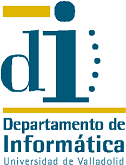1) Knowledge-based Systems for the Supervision and Diagnosis of Dynamic Systems
2) Model Based Reasoning, mainly applied to diagnosis and prognosis of physical systems
3) Machine Learning Techniques: combination of classifiers for time series
4) Applications to Medicine
Line 1: KBS: Knowledge Based Systems for the Supervision and Diagnosis of Dynamic Systems
It was the initial research line of the group. Several industrial prototypes were developed to monitor and diagnose continuous industrial processes in a beet sugar Factory in Spain (known as the OLID family: On-Line Industrial Diagnoser(s)): AEROLID, TEKNOLID, and TURBOLID. A knowledge-model for the different stages for the diagnosis process were developed. Additionally, a characterization of the high-level tasks for global supervision of industrial processes using the Common KADS metholodogy was the other major achievement.
Line 2: MBR: Model Based Reasoning: Diagnosis (Artificial Intelligence approach: consistency-based) and Prognosis using first-principles analytical models.
In this line we have developed techniques for fault diagnosis (fault detection and isolation) and prognosis (estimation of the remaining useful life) of dynamic systems: both continuous and hybrid systems. Hybrid systems are very common in today’s devices, especially in embedded systems, in which a discrete controller commands the operation of a continuous system. A well-known example of this type of system is the anti-lock wheel system, or ABS. In this line, several national projects have been developed in cooperation with Spanish companies, such as GMV and IBERESPACIO and with prestigious international groups, such as the University of Vanderbilt and NASA Ames Research Center.
Main results:
• Diagnosis based on models with Possible Conflicts (PCs), which is concept developed by GSI researchers. This method is based on finding off-line the set of possible conflicts (subsystems with minimal analytical redundancy). They can later be implemented in simulation, observers, DBNs, ssNN,…
• We also provided several architecture proposals for Model-based diagnosis, MBD: Consistency-based Diagnosis with Possible Conflicts
The concept of Possible Conflicts provide a system-decomposition method that was later expanded to different kind of systems (Hybrid Systems), and Distributed systems. Additionally, it can be also used for other tasks such as Model-based prognosis, where a detailed degradation model of the system is used to estimate in advance the remaining useful life of a device or a system (when the component will fail).
Line 3: TA: Development of new Machine Learning Techniques: combination of classifiers and time series (TA)
The group has developed innovative machine learning methods and has applied these techniques to different problems, including the diagnosis of dynamic systems, medical diagnosis and bioinformatics, in particular classification and clustering of microarrays gene expression.
Main results:
• Series Classification
• Series description
• Rules
• Decision Trees on Intervals and Dissimilarity
• Support Vector Machines with Interval Features
Combination of Classifiers
• Boosting of literals
• Based on Rotations
Integration of learning techniques and MBD with PCs
• Application classifiers
• Modifying classifiers to obtain preferences
• Early classification
DBM Integration + Classifiers
• Location: DBC with PCs
• Identification: Modified Classifiers
• Output: preferences (updated) of the failure modes supported by candidates
Line 4: Applications to Medicine: Bioinformatics (Microarray Data Analysis)
DNA microarray technology makes possible to measure the profiles of genetic expression in a biological sample. The classification methods used in the field of machine learning have proved useful for identifying and diagnosing diverse and complex diseases, such as cancer, from the data provided by these biochips. In order to effectively transfer this technology to clinical practice, it is necessary to relate the results obtained by these methods with the underlying biological mechanisms, for which it is necessary to exploit the explicit knowledge present in today’s large biological databases. Thus, research into new methods and techniques that integrate biological knowledge into the task of classifying microarrays poses interesting challenges to the Bioinformatics community.
Three main research fields:
• gene selection
• supervised prediction or classification
• clustering
Products developed
• geneCBR: open source tool for microarray analysis `[http://www.genecbr.org/]
• AIBench: the Artificial Intelligence workBench: [http://www.aibench.org/]
